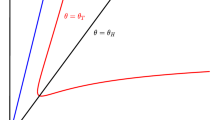Abstract
A stochastic three species predator–prey model with intermediate predator and anti-predator behavior is established and studied in this paper. By constructing suitable Lyapunov functions and combining knowledge of stochastic differential equations, the behavior of global positive solutions to the model are investigated. Firstly, we prove that there is unique global positive solution to the model, and establish the stochastic boundedness of the positive solution as well. Secondly, the sufficient condition for the existence of a unique ergodic stationary distribution is provided. Thirdly, the persistence and extinction of the populations are discussed. Finally, some numerical simulations demonstrate that the results obtained in this paper are true, moreover, the influence of white noise on the populations is revealed.








Similar content being viewed by others
References
Holmes, J.C., Bethel, W.M.: Modification of intermediate host Behaviour by parasites. Behav. Aspects Parasite Transm. 51, 123–149 (1972)
Lingle, Susan, Pellis, Sergio M.: Fight or flight: antipredator behavior and the escalation of coyote encounters with deer. Oecologia 131(1), 154–164 (2002)
Xiao, Dongmei, Zhu, Huaiping: Multiple focus and Hopf bifurcations in a predator–prey system with nonmonotonic functional response. SIAM J. Appl. Math. 66(3), 802–819 (2006)
Choh, Y., Ignacio, M., Sabelis, M.W., Janssen, A.: Predator–prey role reversals, juvenile experience and adult antipredator Behaviour. Sci. Rep. 2, 728 (2012)
Ford, John, Reeves, Randall: Fight or flight: antipredator strategies of baleen whales. Mammal Rev. 38, 50–86 (2008)
Sokol, W., Howell, J.A.: Kinetics of phenol oxidation by washed cells. Biotechnol. Bioeng. 23(9), 2039–2049 (1981)
Freedman, H.I., Ruan, Shigui: Hopf bifurcation in three-species food chain models with group defense. Math. Biosci. 111(1), 73–87 (1992)
Sun, Xiaodan, Li, Yingping, Xiao, Yanni: A predator–prey model with prey population guided anti-predator behavior. Int. J. Bifurc. Chaos 27(07), 1750099 (2017)
Tang, Biao, Xiao, Yanni: Bifurcation analysis of a predator–prey model with anti-predator Behaviour. Chaos Solitons Fractals 70, 58–68 (2015)
Zhao, Xin, Zeng, Zhijun: Stationary distribution of a stochastic predator–prey system with stage structure for prey. Phys. A Stat. Mech. Appl. 545, 123318 (2020)
Raw, S.N., Mishra, P., Tiwari, B.: Mathematical study about a predator–prey model with anti-predator behavior. Int. J. Appl. Comput. Math. 6(3), 68 (2020)
Liu, Qun, Jiang, Daqing: Stationary distribution and extinction of a stochastic one-prey two-predator model with Holling type ii functional response. Stoch. Anal. Appl. 37(3), 321–345 (2019)
Li, Jiang, Liu, Xiaohui, Wei, Chunjin: The impact of role reversal on the dynamics of predator–prey model with stage structure. Appl. Math. Model. 104, 339–357 (2022)
Feng, Tao, Zhou, Hongjuan, Qiu, Zhipeng, Kang, Yun: Impacts of demographic and environmental stochasticity on population dynamics with cooperative effects. Math. Biosci. 353, 108910 (2022)
Feng, Tao, Milne, Russell, Wang, Hao: Variation in environmental stochasticity dramatically affects viability and extinction time in a predator–prey system with high prey group cohesion. Math. Biosci. 365, 109075 (2023)
Kang, Ming, Geng, Fengjie, Zhao, Ming: Dynamical behaviors of a stochastic predator–prey model with anti-predator behavior. J. Appl. Anal. Comput. 13(3), 1209–1224 (2023)
Mandal, P.S., Banerjee, M.: Stochastic persistence and stationary distribution in a Holling-tanner type prey–predator model. Phys. A Stat. Mech. Appl. 391(4), 1216–1233 (2012)
Rudnicki, Ryszard, Pichór, Katarzyna: Influence of stochastic perturbation on prey–predator systems. Math. Biosci. 206(1), 108–119 (2007)
Bandyopadhyay, M., Chattopadhyay, J.: Ratio-dependent predator–prey model: effect of environmental fluctuation and stability. Nonlinearity 18(2), 913–936 (2005)
Liu, Meng, Wang, Ke.: Persistence, extinction and global asymptotical stability of a non-autonomous predator–prey model with random perturbation. Appl. Math. Model. 36(11), 5344–5353 (2012)
Liu, Qun, Jiang, Daqing: Influence of the fear factor on the dynamics of a stochastic predator–prey model. Appl. Math. Lett. 112, 106756 (2021)
Qi, Haokun, Meng, Xinzhu: Threshold behavior of a stochastic predator–prey system with prey refuge and fear effect. Appl. Math. Lett. 113, 106846 (2021)
Qi, Haokun, Meng, Xinzhu, Hayat, Tasawar, Hobiny, Aatef: Stationary distribution of a stochastic predator–prey model with hunting cooperation. Appl. Math. Lett. 124, 107662 (2022)
Wang, Zhaojuan, Deng, Meiling, Liu, Meng: Stationary distribution of a stochastic ratio-dependent predator–prey system with regime-switching. Chaos Solitons Fractals 142, 110462 (2021)
Liu, Rong, Liu, Guirong: Complex dynamics of a stochastic two-patch predator–prey population model with ratio-dependent functional responses. Complexity 2021, 6671499 (2021)
Rajasekar, S.P., Pitchaimani, M., Zhu, Quanxin: Probing a stochastic epidemic hepatitis c virus model with a chronically infected treated population. Acta Math. Sci. 42(5), 2087–2112 (2022)
Zhang, Shengqiang, Meng, Xinzhu, Feng, Tao, Zhang, Tonghua: Dynamics analysis and numerical simulations of a stochastic non-autonomous predator–prey system with impulsive effects. Nonlinear Anal. Hybrid Syst. 26, 19–37 (2017)
Imhof, L., Walcher, S.: Exclusion and persistence in deterministic and stochastic chemostat models. J. Differ. Equ. 217(1), 26–53 (2005)
Ji, Chunyan, Jiang, Daqing, Li, Xiaoyue: Qualitative analysis of a stochastic ratio-dependent predator–prey system. J. Comput. Appl. Math. 235(5), 1326–1341 (2011)
Bao, Jianhai, Shao, Jinghai: Permanence and extinction of regime-switching predator-prey models. SIAM J. Math. Anal. 48(1), 725–739 (2016)
Khasminskii, Rafail: Stochastic Stability of Differential Equations. Springer, Berlin (2011)
Zhao, Yanan, Jiang, Daqing: The threshold of a stochastic sis epidemic model with vaccination. Appl. Math. Comput. 243, 718–727 (2014)
Acknowledgements
We are very grateful to the editor and reviewers for their careful reading and valuable comments, which greatly improved the expressiveness of our paper. This work was supported by the National Natural Science Foundation of China (Grant No. 12001502).
Author information
Authors and Affiliations
Corresponding author
Ethics declarations
Conflict of interest
We declare that we have no conflict of interest.
Additional information
Publisher's Note
Springer Nature remains neutral with regard to jurisdictional claims in published maps and institutional affiliations.
Rights and permissions
Springer Nature or its licensor (e.g. a society or other partner) holds exclusive rights to this article under a publishing agreement with the author(s) or other rightsholder(s); author self-archiving of the accepted manuscript version of this article is solely governed by the terms of such publishing agreement and applicable law.
About this article
Cite this article
Kang, M., Zhang, X., Geng, F. et al. Stationary distribution of a stochastic three species predator–prey model with anti-predator behavior. J. Appl. Math. Comput. 70, 1365–1393 (2024). https://doi.org/10.1007/s12190-024-02007-5
Received:
Revised:
Accepted:
Published:
Issue Date:
DOI: https://doi.org/10.1007/s12190-024-02007-5




